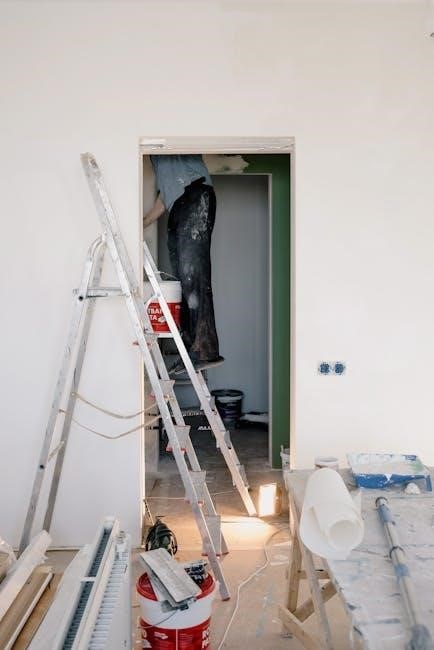The Advanced Diploma of Civil Construction Design (RII60520) is a nationally recognized qualification under ANZSCO 312212, focusing on design, construction, and project management in civil engineering.
1.1 Overview of the Qualification
The Advanced Diploma of Civil Construction Design (RII60520) is a specialized qualification designed for professionals seeking to enhance their skills in civil engineering design and construction management. This course focuses on advanced technical knowledge, project management, and practical application of engineering principles. It consists of 12 core units, covering design, planning, and execution of infrastructure projects. Graduates gain expertise in designing roads, bridges, and other civil structures, preparing them for roles like civil engineering designer or project manager. The qualification aligns with ANZSCO 312212, making it relevant for migration and skill assessment purposes in Australia.
1.2 Importance of Skill Assessment for Migration
A skill assessment is critical for migration purposes, as it evaluates whether your qualifications and experience meet Australian standards for civil construction design roles. Engineers Australia (EA) conducts these assessments to ensure applicants have the necessary skills for visa and permanent residency applications. A positive outcome is essential for securing migration pathways, including the Temporary Residence (TR) and Permanent Residence (PR) visas. The assessment verifies your expertise in civil construction design, aligning with ANZSCO 312212, and ensures your qualifications are recognized for skilled migration. This process is vital for individuals aiming to work and settle in Australia.

Eligibility Criteria for Skill Assessment
Eligibility requires holding an Advanced Diploma in Civil Construction Design, meeting work experience criteria, and satisfying age and other specified requirements for skill assessment.
2.1 Academic Qualifications Required
The primary academic requirement is an Advanced Diploma of Civil Construction Design (RII60520). This qualification must be awarded by a recognized Australian educational institution. Applicants must provide an official academic transcript and degree certificate for verification. The curriculum should cover core units such as civil design, construction planning, and project management. Engineers Australia assesses whether the qualification aligns with the ANZSCO 312212 standards. Additionally, the diploma should include relevant coursework in civil engineering principles, ensuring it meets the skill level requirements for migration purposes. Accreditation by Engineers Australia is highly recommended to streamline the assessment process.
2.2 Work Experience Requirements
Applicants must demonstrate a minimum of 4 years of relevant work experience in civil construction design. At least 1 year of this experience should be within the last 5 years. Engineers Australia requires evidence of employment in roles directly related to ANZSCO 312212, such as designing infrastructure projects or managing construction activities. The experience should include tasks like project planning, site supervision, and technical problem-solving. Documentary evidence, such as employment letters and project reports, must be provided to validate the experience. This requirement ensures applicants have practical skills aligned with the Advanced Diploma qualification and industry standards.
2.3 Age and Other Eligibility Factors
Age is not a direct eligibility criterion for the Advanced Diploma of Civil Construction Design skill assessment. However, applicants must ensure their qualifications and work experience meet Engineers Australia’s updated standards. Effective September 1, 2024, only qualifications accredited by Engineers Australia are eligible for assessment. Additionally, maintaining up-to-date skills and continuous professional development are crucial for meeting the evolving requirements. While age is not a barrier, applicants must demonstrate relevance of their experience and adaptability to industry changes, ensuring compliance with the latest assessment guidelines set by Engineers Australia.

Required Documents for Skill Assessment
Key documents include a detailed CV, academic certificates, project reports, and supporting evidence. Ensure all meet Engineers Australia’s standards for a successful assessment.
3.1 CV/Resume Requirements
Your CV/Resume must include a detailed summary of your engineering education, work experience, and skills. Engineers Australia requires a comprehensive description of your roles, responsibilities, and achievements. Ensure your CV highlights specific projects, technical skills, and tasks relevant to civil construction design. Include dates, job titles, and organizations to provide clarity. Avoid generic statements and focus on measurable outcomes. Tailor your CV to align with the ANZSCO 312212 (Civil Construction Design) occupation, emphasizing design, construction, and project management experiences. Accuracy and relevance are crucial for a positive skill assessment outcome.
3.2 Academic Degree Certificate
Your Academic Degree Certificate must be submitted as part of the skill assessment process. It should clearly state the qualification awarded, such as the Advanced Diploma of Civil Construction Design (RII60520), and be issued by a recognized educational institution. Engineers Australia requires proof of completion of the 12 core units specific to this diploma. Ensure the certificate is certified and includes the institution’s official seal or stamp. If your certificate is in a language other than English, provide a certified translation. This document is critical for verifying your academic credentials and aligning them with the skill level requirements for migration purposes.

3;3 Project Reports and Work Samples
Submitting detailed project reports and work samples is essential for a successful skill assessment. These documents demonstrate your practical expertise in civil construction design. Include reports from significant projects showcasing your involvement in design, problem-solving, and project outcomes. Work samples should highlight your technical skills, such as CAD designs, engineering calculations, or site plans. Ensure the samples are relevant to the ANZSCO 312212 occupation and align with the core units of the Advanced Diploma. Engineers Australia (EA) reviews these to verify your ability to apply theoretical knowledge in real-world scenarios. Select projects that best illustrate your competencies and contributions to civil construction projects.
3.4 Other Supporting Documents
Besides academic and work-related documents, include additional evidence to strengthen your application. Provide letters from employers confirming your job roles and responsibilities, especially those relevant to civil construction design. Statutory declarations can address gaps in work history or unclear documentation. Include English proficiency test results if required. Professional references and any certifications, such as OHS or project management, add credibility. Ensure all documents are certified and translated if necessary. These supporting materials help Engineers Australia assess your eligibility and alignment with the Advanced Diploma requirements, ensuring a comprehensive evaluation of your skills and experience.

Skill Assessment Process
The skill assessment process is systematically managed by Engineers Australia, utilizing pathways like the CDR. Recent updates have been made to align with industry standards and effectiveness.
4.1 Steps Involved in the Assessment
The assessment process begins with submitting required documents, including a CV, academic certificates, and project reports. Engineers Australia reviews these to verify qualifications. Next, a technical evaluation assesses the alignment of coursework and work experience with the occupation’s requirements. For CDR pathway applicants, a Competency Demonstration Report is thoroughly examined. The process also involves a committee review to ensure all criteria are met. Applicants may receive feedback or requests for additional information. Upon completion, a positive or negative outcome is communicated, determining eligibility for migration under the specified ANZSCO code.
4.2 Role of Engineers Australia (EA)
Engineers Australia (EA) is the assessing authority for engineering qualifications, including the Advanced Diploma of Civil Construction Design. EA evaluates academic credentials, work experience, and project reports to determine if they meet the required standards for migration. They ensure applicants demonstrate competency in the 12 core units of RII60520, aligning with ANZSCO 312212. EA also reviews CDR reports for skills assessment, providing feedback and verification. Their role is critical in maintaining the integrity of the assessment process and ensuring applicants meet the necessary requirements for skilled migration pathways in Australia.
4.3 Use of the CDR Pathway
The CDR (Competency Demonstration Report) pathway is a critical method for Advanced Diploma holders to demonstrate their engineering competencies to Engineers Australia (EA). This pathway requires applicants to submit a detailed report showcasing their skills in design, construction, and project management. The CDR includes a CV, summary statement, and project reports, proving their ability to meet the required engineering standards. While the CDR pathway provides an opportunity for a positive skill assessment, challenges remain, particularly in aligning the Advanced Diploma’s core units with EA’s expectations. Proper preparation and evidence submission are essential for success in this assessment process.

Challenges in Meeting Skill Assessment Requirements
The Advanced Diploma’s 12 core units may not fully meet Engineers Australia’s requirements. Updates to EA’s assessment approach and work experience gaps pose additional challenges.
5.1 Concerns Raised by Engineers Australia
Engineers Australia has raised concerns that the 12 core units of the RII60520 Advanced Diploma may not fully meet the required skills for migration assessments. This is significant, as it directly impacts applicants’ ability to demonstrate competency in civil construction design. EA emphasizes the need for qualifications to align closely with the ANZSCO 312212 requirements. Additionally, EA has highlighted the importance of relevant work experience and the need for qualifications to be accredited by Engineers Australia. These concerns underscore the challenges applicants face in meeting the stringent criteria for skill assessments.
5.2 Core Units of the RII60520 Advanced Diploma
The RII60520 Advanced Diploma includes 12 core units focused on civil construction design, covering essential skills like project management, design processes, and construction methods. These units are designed to align with industry standards and prepare graduates for roles in civil engineering. However, Engineers Australia has expressed concerns that these units may not fully meet the competencies required for migration assessments under ANZSCO 312212. This has led to a closer scrutiny of how these units address technical and practical skills. The core units remain critical for demonstrating expertise in civil construction design and project planning.
5.3 Work Experience Gaps and Solutions
Work experience gaps can pose challenges for skill assessment, particularly for Advanced Diploma holders. Engineers Australia requires a minimum of three years of relevant employment, with at least one year within the last five years. Gaps in employment or lack of relevant work experience may lead to assessment delays or rejection. To address this, applicants can undertake further studies, pursue professional development courses, or gain additional work experience in civil construction design. Demonstrating continuous skill development and alignment with industry standards is crucial for overcoming these gaps and meeting the migration requirements effectively.

Updates to Engineers Australia’s Assessment Approach
Engineers Australia updated its assessment approach effective September 1, 2024, requiring qualifications to be accredited and ensuring work experience aligns with industry standards for migration purposes.
6.1 Changes Effective from 1 September 2024
Engineers Australia introduced significant updates to its skill assessment process starting 1 September 2024. These changes require qualifications to be accredited by Engineers Australia for migration purposes. Applicants with an Advanced Diploma of Civil Construction Design must ensure their qualifications align with the updated standards. The new approach emphasizes the importance of relevant work experience, with a minimum of four years required for certain categories. Additionally, Engineers Australia has raised concerns about the 12 core units of the RII60520 Advanced Diploma, stating they may not fully meet the required skill assessment standards. These changes aim to streamline the migration process and ensure alignment with industry demands.
6.2 Impact on Advanced Diploma Holders
The updates to Engineers Australia’s assessment approach have significant implications for Advanced Diploma holders. While the RII60520 Advanced Diploma remains a valid qualification under ANZSCO 312212, the new requirements may necessitate additional steps for applicants. Holders must now ensure their qualifications are accredited by Engineers Australia or meet the updated standards. This shift may require some individuals to provide further evidence, such as additional work experience or bridging courses, to satisfy the migration skills assessment criteria. These changes aim to ensure alignment with industry standards but may pose challenges for those relying solely on the Advanced Diploma for migration purposes.

Understanding the Four Engineering Occupational Categories
The four engineering categories are Engineering Manager, Engineering Professional, Engineering Technician, and Engineering Trades Worker, each with distinct roles and skill levels under the ANZSCO framework.
7.1 ANZSCO Code 312212 (Civil Construction Design)
ANZSCO Code 312212 pertains to Civil Construction Designers, who prepare designs, plans, and specifications for civil engineering projects. This role requires an Advanced Diploma in Civil Construction Design or equivalent. Engineers Australia assesses qualifications and work experience for migration under this code. Applicants must demonstrate expertise in design, construction, and project management. The role aligns with Skill Level 2 under the Australian Skilled Occupation List, necessitating a relevant qualification and at least one year of relevant work experience. This code is crucial for those applying for Temporary Residency or Permanent Residency in Australia.
7.2 Skill Level 2 Requirements
Skill Level 2 under the Australian Skilled Occupation List requires applicants to hold an AQF Associate Degree, Advanced Diploma, or Diploma. For Civil Construction Design (ANZSCO 312212), this typically involves completing an Advanced Diploma of Civil Construction Design. Additionally, applicants must demonstrate at least one year of relevant work experience. This experience should align with the tasks and responsibilities outlined in the ANZSCO description, such as preparing designs, plans, and specifications for civil engineering projects. Engineers Australia verifies these requirements during the skill assessment process to ensure applicants meet migration criteria. This aligns with the pathway for Temporary Residency or Permanent Residency in Australia.

Preparing for the Skill Assessment Application
Preparing for the skill assessment involves organizing documents, understanding requirements, and ensuring accuracy in submissions. Proper structuring of CVs and certificates is crucial for approval.
8.1 Tips for a Well-Structured CV/Resume
A well-structured CV for skill assessment should include a detailed summary of engineering education and work experience. Begin with personal information and a professional objective. List academic qualifications, emphasizing the Advanced Diploma of Civil Construction Design and relevant coursework. In the work experience section, describe roles and responsibilities, focusing on projects related to civil construction design and management. Highlight specific achievements and use quantifiable outcomes to demonstrate capabilities. Include a skills section with technical proficiencies, such as AutoCAD or Revit. Mention volunteer work or internships for additional context. Ensure clarity and conciseness, using bullet points for readability. Avoid unnecessary personal details and consider having the CV reviewed by a professional. This structured approach ensures alignment with the requirements of Engineers Australia and effectively showcases qualifications for the skill assessment.
8.2 Ensuring Academic Certificates Meet Standards
Academic certificates for the Advanced Diploma of Civil Construction Design must meet specific standards for skill assessment. Ensure your certificate is issued by a recognized educational institution and includes the qualification title, course duration, and completion date. Certificates must be in English or accompanied by a certified translation if originally in another language. Verify that the document is authenticated, either through notarization or an official seal, to avoid rejection. Engineers Australia requires clear evidence of qualification completion, so ensure all details are legible and accurately reflect your academic achievements. Properly formatted and authenticated certificates are essential for a smooth assessment process.
8.3 Best Practices for Submitting Project Reports
When submitting project reports for skill assessment, ensure they align with Engineers Australia’s requirements. Select projects that demonstrate technical skills in civil construction design, such as design calculations, problem-solving, and project management. Include detailed descriptions of your role, responsibilities, and contributions. Use clear, concise language and avoid jargon. Ensure reports are well-structured with an introduction, methodology, results, and conclusion. Highlight practical applications of your knowledge and compliance with industry standards. Visual aids like diagrams or charts can enhance understanding. Proofread for clarity and accuracy, and ensure the report is professionally formatted. This will help showcase your expertise effectively.

Migration and PR Pathways
Engineers Australia now requires Advanced Diploma holders to meet updated migration pathways, including accredited qualifications and a minimum of four years’ relevant work experience for PR applications.
9.1 Understanding the TR Application Process
Applicants with an Advanced Diploma in Civil Construction Design must meet specific requirements for a Temporary Resident (TR) visa. Engineers Australia’s updated assessment approach, effective from 1 September 2024, mandates that qualifications must be accredited by them for eligibility. To apply, candidates need to submit a CV detailing their engineering education and work experience, along with an academic degree certificate. Additionally, at least one year of relevant work experience is required. The process involves a skills assessment, which evaluates whether the applicant’s qualifications and experience align with ANZSCO 312212 standards. This pathway is a critical step toward achieving permanent residency in Australia.
9.2 PR Pathway with an Advanced Diploma
Holders of the Advanced Diploma of Civil Construction Design can pursue permanent residency (PR) in Australia through specific pathways. The qualification aligns with ANZSCO 312212, categorizing it as Skill Level 2. Applicants must undergo a skills assessment by Engineers Australia, ensuring their diploma meets the required standards. Relevant work experience, typically a minimum of three years, is crucial for a positive assessment. Post-assessment, applicants can apply for PR through General Skilled Migration programs, such as the Subclass 189 or 190 visas. This pathway offers a structured route for civil construction design professionals to achieve PR in Australia.
The Advanced Diploma of Civil Construction Design is a valuable qualification for migration, offering pathways to PR through skills assessment and adherence to Engineers Australia’s standards.
10.1 Summary of Key Requirements
Obtaining a positive skill assessment requires an Advanced Diploma in Civil Construction Design, relevant work experience, and compliance with Engineers Australia’s updated standards. Candidates must hold an AQF-recognized qualification, demonstrate at least four years of relevant employment, and ensure their CV and academic certificates meet specified criteria. Engineers Australia’s accreditation of qualifications post-September 2024 is now mandatory. Proper documentation, including project reports and work samples, is essential for a successful application. Adhering to these requirements ensures alignment with ANZSCO 312212 standards and enhances chances of approval for migration pathways.
10.2 Encouragement for Applicants
Applicants pursuing the Advanced Diploma of Civil Construction Design are encouraged to remain proactive and thorough in their preparation. Staying informed about Engineers Australia’s updated requirements and ensuring all documents meet the specified standards is crucial. By carefully preparing CVs, academic certificates, and project reports, candidates can significantly enhance their chances of a positive skill assessment. This qualification opens pathways to permanent residency and rewarding career opportunities in Australia’s growing engineering sector. Persistence and attention to detail will yield long-term benefits for aspiring professionals in this field.